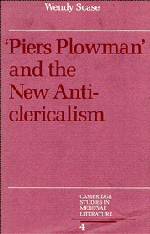Book contents
- Frontmatter
- Contents
- Preface
- Acknowledgements
- Note on quotations and references
- List of abbreviations
- 1 Introduction: tradition and the new anticlericalism
- 2 The usurpation of priestly power and the transformation of an antifraternal satire
- 3 Poverty: an old controversy and a new polemic
- 4 Charity: the ground of anticlericalism
- 5 Antireligious traditions and a new satire in the C-text
- 6 Clerical dominion and authority in new anticlerical literature
- Notes
- Bibliography
- General index
- Index of Piers Plowman citations
5 - Antireligious traditions and a new satire in the C-text
Published online by Cambridge University Press: 09 February 2010
- Frontmatter
- Contents
- Preface
- Acknowledgements
- Note on quotations and references
- List of abbreviations
- 1 Introduction: tradition and the new anticlericalism
- 2 The usurpation of priestly power and the transformation of an antifraternal satire
- 3 Poverty: an old controversy and a new polemic
- 4 Charity: the ground of anticlericalism
- 5 Antireligious traditions and a new satire in the C-text
- 6 Clerical dominion and authority in new anticlerical literature
- Notes
- Bibliography
- General index
- Index of Piers Plowman citations
Summary
THE DOMINION OF THE RELIGIOUS ORDERS AND THE NEW ANTI CLERICALISM
Loke now where this lollares and lewede ermites,
Yf they breke pis obedience pat beth so fer fram chirche.
Where se we hem on Sonendayes the seruise to here,
As matynes by pe morwe? Til masse bygynne,
Or Sonendayes at euensong, se we wel fewe,
Or labory for here lyflode as pe lawe wolde.
Ac aboute mydday at mele-tyme y mette with hem ofte,
Come in his cope as he a clerk were;
A bacheler or a bew-pere beste hym bysemede,
And for pe cloth pat keuereth hym ykald he is a frere …
(C ix 240–9)The loller is called a friar ‘for pe cloth pat keuereth hym’: because he wears a habit. Faus Semblant, in the Roman de la Rose, quoted (and exemplified) a well-known proverb which summed up a tradition: ‘la robe ne fet pas le moine’. In traditional satire against the religious orders, wearing the habit signifies deceptive appearances, false-seeming. On the surface, it shows adherence to the rule of a religious order. Underneath, it may conceal the opposite. The satirists often borrowed imagery from Matt. 7:15: ‘Beware of false prophets, men who come to you dressed up as sheep while underneath they are savage wolves.’ Thus Faus Semblant:
Dehors semblons aigneaus pitables,
dedanz somes lous ravisables …
Another image common in traditional antireligious satire was that of the fox dressed in a habit. Faus Semblant confesses to ‘renardie’ – ‘foxerie’ – in the Middle English translation. Use of the image for friars in the Collectiones by William of St Amour explains why antireligious satirists found the tradition so attractive.
- Type
- Chapter
- Information
- Piers Plowman and the New Anticlericalism , pp. 120 - 160Publisher: Cambridge University PressPrint publication year: 1989



